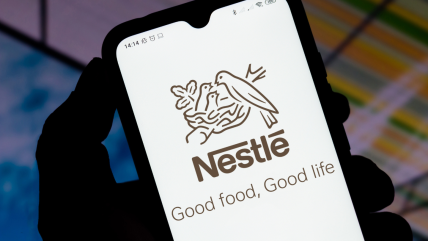
Nestlé CEO Mark Schneider has exuded confidence that a key volume metric will turn positive after declining for six of the last seven quarters.
Speaking at a fireside chat with JPMorgan consumer equity analyst Celine Pannuti, Schneider also had some optimistic tones for gross-margin progress and market-share gains with one month to go until the second quarter ends.

Discover B2B Marketing That Performs
Combine business intelligence and editorial excellence to reach engaged professionals across 36 leading media platforms.
“We are well positioned to make good on what we laid out to you in our Q1 call. And that is that swing over to noticeable positive RIG growth in the second quarter, and then consistent delivery thereafter,” he told Pannuti.
Presenting the first-quarter results to the end of March in April, Schneider had said Nestlé was “spring loaded for a significant rebound” in real internal growth. RIG, which strips out the effect of pricing from organic growth to reflect changes in volume, fell 2% in the opening three months.
Schneider said Nestlé is sticking with its 4% organic growth outlook for the year, although with wiggle room to exceed that, despite the metric decreasing 1.4% last quarter, a fourth straight quarterly decline.
“That’s supposed to mean a backdoor three to five but rather narrowly centred around 4%. And that’s still our best estimate at this moment,” he said.

US Tariffs are shifting - will you react or anticipate?
Don’t let policy changes catch you off guard. Stay proactive with real-time data and expert analysis.
By GlobalDataAsked for some perspective on volumes, Schneider coined his response in the food-industry context, putting Nestlé in the same position as its peers.
“It’s important to separate between the market-related items, the fact that after two years of significant inflation, virtually everyone in our industry had paid a penalty on volumes. Clearly, you had to react to the food-price inflation with price increases, and then at some point there was that consumer reaction and no one was really immune from that.
“On that side, and the fact that RIG delivery as a result of that over the last five to six quarters had been somewhat unsteady, that is something that’s part of the industry.
“And given that this was literally a one-in-50-year event, I think it’s important to not take that as an argument against the company, or the industry for that matter.”
Nestlé has yet to recover pre-pandemic gross margins of circa 50%. They increased 70 basis points in the 2023 financial year to 45.9%.
“We are in the middle of this period of gross-margin recovery. There's generally belief coming to the P&L from the fact that the worst of the inflation wave is behind us,” Schneider said. “The fundamental direction, that the gross margin continues to improve, that applies.”
The positive direction on gross margins will also aid another key Nestlé metric – the underlying trading operating profit margin (UTOP) – as the CEO said he is confident of hitting the 2024 target of 17.5% to 18.5% supported by “a higher rate of investments into innovation, renovation and brand support”.
Schneider was sanguine on market share, too, partly led by those three factors, and particularly in the US.
“Compared to December last year, what we're seeing now, especially around our billionaire brands, is some green shoots on market share. There has been about a 5% increase in the sales, that shows positive development,” he told Pannuti.
“For the all-important US market, we do have significant new items on shelf now that came on shelf late Q1, beginning of Q2, most notably around functional waters, pet care and also frozen food.”
Amid the push back from consumers to price increases and the net effect on volumes, Schneider said the reaction in North America was “exacerbated” by last year’s reduction in SNAP food support payments.
“That was certainly strongly felt in the second half of last year and also in the first quarter of this year. Starting from the second quarter, at least that year-over-year comparison begins to clean up again,” he explained.
He had a note of caution on volume recovery – the pain felt by consumers, which the CEO suggested was not exclusive to Nestlé.
“The underlying consumer sentiment, that is something that doesn't repair from one quarter to another. When we hear exuded confidence on the second quarter and the second half of the year, this is not built on an overly positive view on how the consumer confidence all of a sudden magically reappears.”
As inflation wanes, Schneider reiterated Nestlé will take a more “nuanced” approach to further pricing, which amounted to 3.4% across the group in the first quarter, down from as high as 10% in 2022.
“We're entering a phase where it's a much more nuanced picture. You still have individual commodities, cocoa of course making the headlines, or coffee trending up. But then what you don't have is this groundswell of all commodities and energy and labour heading up, and so that differentiates 2024 from where we were at the beginning of ’22,” he explained.





